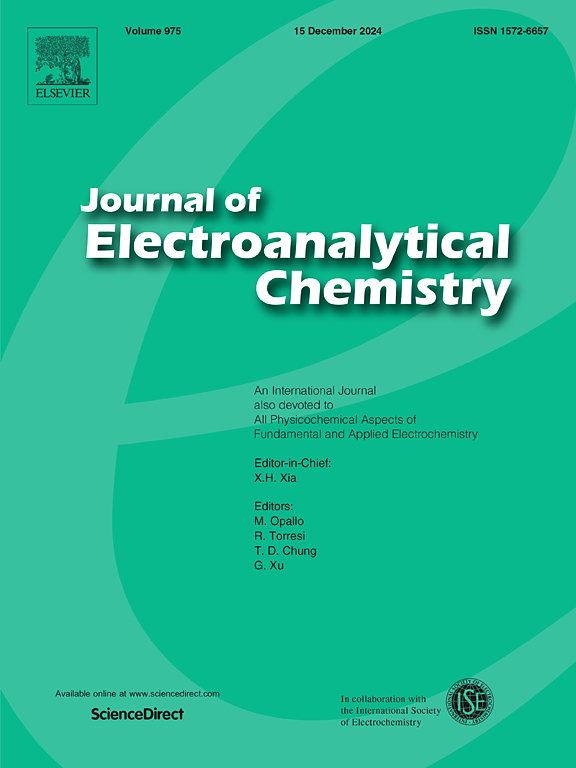Synergistic enhancement of sodium-ion storage performance in Na3V2(PO4)3/C cathode materials via Eu3+ doping and carbon coating
IF 4.1
3区 化学
Q1 CHEMISTRY, ANALYTICAL
引用次数: 0
Abstract
In recent years, Na3V2(PO4)3(NVP) has emerged as a promising cathode material for sodium-ion batteries (SIBs) due to its stable NASICON-type framework, high theoretical capacity (∼117.6 mAhg−1), and suitable operating voltage (∼3.4 V vs. Na+/Na). However, the practical application of NVP is hindered by its intrinsically low electronic conductivity, which significantly limits its electrochemical performance. This study systematically investigates the effects of Eu3+ doping on the crystal structure, electronic conductivity, and electrochemical properties of NVP. The results findings demonstrate that optimal Eu3+ doping effectively expands sodium-ion diffusion pathways while stabilizing the NASICON framework. Structural analyses (XRD, XPS) confirmed successful Eu3+ incorporation without altering the host framework. Electrochemically, the optimized 0.03Eu-NVP/C composite delivered a reversible capacity of 109.94 mAhg−1 at 0.1C, outstanding cycling stability (93.69 % retention after 600 cycles at 1C), and remarkable long-term performance (92.15 % retention after 3000 cycles at 20C). Kinetic studies revealed enhanced Na+ diffusion coefficients and pseudocapacitive contributions, underscoring the efficacy of this dual-modification approach for high-performance sodium-ion batteries. Furthermore, the introduction of a carbon-coating layer substantially enhances the overall electronic conductivity of the material. The results conclusively demonstrate that Eu3+-doped Na3V2(PO4)3/C represents a highly promising cathode material for high-performance sodium-ion batteries.
Eu3+掺杂与碳包覆协同增强Na3V2(PO4)3/C正极材料的钠离子存储性能
近年来,Na3V2(PO4)3(NVP)因其稳定的nasiconon型框架、高理论容量(~ 117.6 mAhg−1)和合适的工作电压(~ 3.4 V vs. Na+/Na)而成为钠离子电池(sib)极具前景的正极材料。然而,NVP的实际应用受到其固有的低电子导电性的阻碍,这极大地限制了其电化学性能。本研究系统地研究了Eu3+掺杂对NVP晶体结构、电导率和电化学性能的影响。结果表明,最佳的Eu3+掺杂可以有效地扩展钠离子扩散途径,同时稳定NASICON框架。结构分析(XRD, XPS)证实了Eu3+的成功掺入,而没有改变宿主骨架。电化学性能表明,优化后的0.03Eu-NVP/C复合材料在0.1C时的可逆容量为109.94 mAhg−1,具有良好的循环稳定性(在1C下循环600次后保留率为93.69%),在20C下循环3000次后保留率为92.15%)。动力学研究表明,Na+扩散系数和赝电容的贡献增强,强调了这种双重修饰方法对高性能钠离子电池的有效性。此外,碳涂层的引入大大提高了材料的整体电子导电性。结果表明,Eu3+掺杂Na3V2(PO4)3/C是一种非常有前途的高性能钠离子电池正极材料。
本文章由计算机程序翻译,如有差异,请以英文原文为准。
求助全文
约1分钟内获得全文
求助全文
来源期刊
CiteScore
7.80
自引率
6.70%
发文量
912
审稿时长
2.4 months
期刊介绍:
The Journal of Electroanalytical Chemistry is the foremost international journal devoted to the interdisciplinary subject of electrochemistry in all its aspects, theoretical as well as applied.
Electrochemistry is a wide ranging area that is in a state of continuous evolution. Rather than compiling a long list of topics covered by the Journal, the editors would like to draw particular attention to the key issues of novelty, topicality and quality. Papers should present new and interesting electrochemical science in a way that is accessible to the reader. The presentation and discussion should be at a level that is consistent with the international status of the Journal. Reports describing the application of well-established techniques to problems that are essentially technical will not be accepted. Similarly, papers that report observations but fail to provide adequate interpretation will be rejected by the Editors. Papers dealing with technical electrochemistry should be submitted to other specialist journals unless the authors can show that their work provides substantially new insights into electrochemical processes.

 求助内容:
求助内容: 应助结果提醒方式:
应助结果提醒方式:


